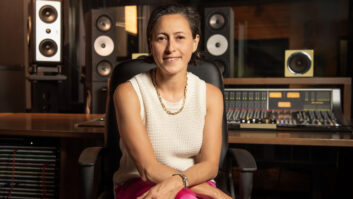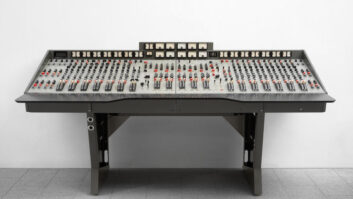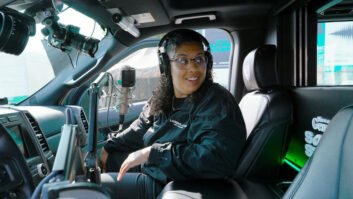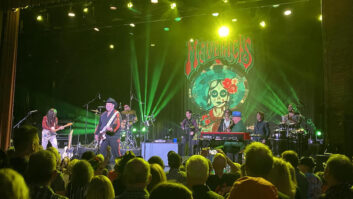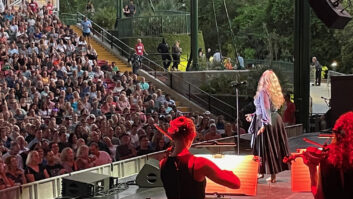It isn’t easy to go back into the studio to record a follow-up album to the kind of smash that No Doubt had with Tragic Kingdom. Tenacity was one word producer Glen Ballard used in describing the band’s attitude toward the making of their latest Trauma/Interscope offering, Return of Saturn. Heroic was another word he offered about the process, which included two false starts and one mistaken completion.
The band had begun to write material early in 1998. They spent that year making demos and then began recording with Tragic Kingdom producer Matthew Wilder. But according to the band’s drummer, Adrian Young, the group probably wasn’t quite ready to record and “the magic wasn’t happening, for whatever reason.” Recovering from that false start, they were finally a week-and-a-half away from leaving to record in New York with producer Michael Beinhorn when they received word that he was busy with the Verve Pipe and would have to postpone the No Doubt project. They picked themselves up from that disappointment and were very relieved when they hit it off with Glen Ballard, who has worked his production magic with Alanis Morissette, among others, in recent years.
Ballard spent three weeks with No Doubt at SIR sorting through material. He charted each of the 40 songs they had written in the same way they approached the second half of Tragic Kingdom-post Eric Stefani’s departure-with acoustic guitar or bass, a tape recorder and singer Gwen Stefani improvising in a room. Ballard helped the group hone the material before suggesting what he considered to be the most cohesive group of songs for the album.
“I didn’t necessarily hear the vision for the record out of those 40, but I was thinking that out of ten or 15 of them, there was. Everyone is emotionally tied to songs they write, so there was probably about 30 seconds of hesitation when I said, ‘I think we should leave these 20 songs behind, and these are the ones we should work on.’ It’s like performing triage,” Ballard says with a laugh. “They were very mature about it.”
In March of last year, they took over Burbank’s Royaltone Studios and spent seven weeks recording the album. On the first day of tracking, they decided to record to Pro Tools. “We did some blind listening, putting the same programmed material on the analog. The band went out and ran down a song, put it into the Pro Tools, put it on the analog and we closed our eyes. It was really hard to hear the difference. Royaltone has a wonderful vintage Neve console, great Studer machines and a lot of great analog gear,” Ballard says. “The band and I love the analog sound and think it’s appropriate for what they do as a real band playing in the studio, but the conveniences and modular nature of recording onto the Pro Tools platform was very attractive to everyone.
“My whole philosophy with the Pro Tools is I try to put as much of the analog stage in front and have the Pro Tools be the storage medium and, obviously, the editing medium,” Ballard explains. “We’re in a world-class studio and a great-sounding room to begin with, so right out of the box, that’s still the most important thing. I always say if it’s sounding good in the room, you can put it on just about anything and it will sound good. If it’s not sounding good in the room, the better the recording, the worse it will sound because it will expose all the deficiencies. Alain Johannes, who recorded the album, is a real Pro Tools expert so he’s able to use plug-ins in such a musical way. I really learned a lot from him.”
According to Ballard, the studio had ideal isolation while maintaining visual contact between the musicians. “They could all see each other, so they were playing together, but we had great control over all the elements that were coming in,” he says. “The guitar room was completely soundproofed, Tony’s bass was isolated, and Gwen had her own isolated vocal booth. I’m very fond of the LA-2A as a compressor/limiter, and a lot of the time vocals would go through that. I think we used an Avalon tube preamp on Gwen’s vocals a lot, and we ended up using a C-12 on a couple of her vocals and mostly a Telefunken 251.”
While they cut live to a click, guitarist Tom Dumont says then they’d go back in, person by person, to recut most of the parts. “More than half the time I would trash what I was doing and come up with completely new guitar parts,” Dumont explains. “With the drums, bass and vocal on there, sometimes the part I had been playing changed. It’s different playing something live from hearing it back in the studio and being able to craft something that really supports the other instruments. You get to listen to what they’re doing, leave space for the vocal and emphasize whatever the vocal is doing emotionally. Some songs were really simple, like ‘Bathwater.’ I think there were two tracks of guitar, but it sounds like one guitar part. There’s kind of a lead part and then a part that locks in on the verses with the bass and drums really closely. That one has a cool groove.
“‘Suspension Without Suspense’ had a lot more going on layering-wise,” he continues. “It’s a mellower song, and it has a couple of acoustic guitars layered and then a guitar playing through a Leslie. ‘Too Late’ is one that was recorded similar to how we did Tragic Kingdom where there were a couple of different guitar parts and each one was doubled and thickened up. Whenever possible, I attempted to simplify, compared to the way we did it last time, and I tried not to double everything, but tried to get one guitar to sound good enough to be full and fill in the space by itself.”
For the drums, which were also isolated and baffled, Plexiglas shields gave drummer Adrian Young a slap-back effect that he desired, and the subwoofers simulated a live concert feeling for him. “When we were at SIR early on working with [producer] Sean Bevin, he put me up on a riser with stage subwoofers, full blast,” explains Young. “I really liked the way it made the demo sound, so I took that idea over to Royaltone.”
“One of the [original] drum tracks wasn’t done at Royaltone [‘Suspension Without Suspense’],” Ballard says. “We really liked the drum sound that we got in pre-production, so we reprocessed it through the room at Royaltone. We did it in a smaller room and then broadcast it through the monitors so it sounded like that room, which was Alain’s idea. Then we recorded it as if it had been played in the room, and it sounded like it had.
“Parts of some of the demos we cut at my studio found their way into the record,” Ballard notes. “I always believe that any time you cut something, if you take a little care in making sure it’s recorded well and it’s in some sequencing logic, you can always use it. And that’s the time to get good stuff, more than ever, because people are not self-conscious. We used bits and pieces from those sessions. It was in Pro Tools, all locked to a sequencer, there was always a click, so it traveled very easily with us.”
By last summer, No Doubt had turned in the record, which was set for a pre-Christmas release. It had been mastered, and the group members were all in their homes listening to the finished product. Unexpectedly, the group members independently agreed they weren’t completely happy with the CD.
“We all called each other naturally going, ‘This isn’t there yet. Something’s missing,'” Dumont recalls. “A lot of the songs came out a little more toned down on the tempo and energy side, and we felt like it needed some more energy-that we’ve always been so good at that. Glen totally hung for the whole thing. That guy has so much on his plate and he had already delivered what his contract outlined. He could have just taken off, but he wanted to help us make the thing great.”
“I don’t get involved with projects halfway,” says Ballard, who was working simultaneously with Lisa Marie Presley and supervising the upcoming Titan A.E. soundtrack. “To me, we were in this together, and I had to see it through. I didn’t disagree that we really needed to get an opening single. It’s always hard at the end of a real artistic experience-one that has drained everybody-to step back and look at the broad picture. They’re all so mature and smart, and even within the sort of crushing emotional burden of having to think about opening it up one more time to try to give a little more blood, nobody said no.”
First they recut “Magic’s in the Makeup,” which was actually the third time the song was recorded, Ballard explains. “They had recorded it once before I had gotten involved. After we recorded it again, everyone felt there were elements in both recordings that were good, but neither was the definitive version. The final version is more true to the song. The chorus of that song has kind of a descrescendo, which is unusual, where you get to the chorus and the drums go away. With my commercial hat on, I thought, ‘We have to make the chorus bigger here,’ but at the end of the day, I agreed that it should be a mellower chorus. So we brought the song back to its original design, and I think it does work best.”
The other song cut at the eleventh hour was the first single, “Ex-Girlfriend.” “We wrote that one at my house,”
Dumont says. “I have a little Cubase recording system in my home studio. I had heard that Dr. Dre would copy loops from old soul and funk records and re-create the drum loops and the grooves to use it as a jumping-off point in a song. We decided to do that. We had a Tricky album and put on this song that had kind of a reggae groove. I re-created it with my sampler, beat for beat, and we ended up crafting the song from that. I recorded the song into Cubase and created a two-bar loop and then we got rid of the Tricky thing. As we developed the song over that, we ended up coming up with something completely different from what Tricky had in his song, and by the time we got into the studio to record it, Adrian created all new loops and sounds so the beat ended up sounding nothing like it. But it was an interesting experiment, and it worked really well.”
They recorded “Ex-Girlfriend” and re-recorded “Magic’s in the Makeup” at Ocean Way, which logistically worked out well in many ways.
“While we were tracking, Jack Joseph Puig was mixing the record right next door in the same building at Ocean Way, so it was just a walk down the hall to give him what we mixed at that last minute,” Dumont says. “He brought so much to it after the fact and did an amazing job of making great choices about what we presented him. I try to sort through it all initially, but there’s always a little bit of extra, and another set of ears like his to say, ‘I hear it this way,’ is valuable.”
Dumont says he’s pleased they went the extra mile on Return of Saturn. “Everything happens for a reason, and we’re glad it didn’t come out at Christmas. There was so much out, it would not have been a great time for us. Now we feel really good about the music. We had to think, ‘If this were our last record and the last thing we were to leave the world, we have to make it as good as we can.'”

